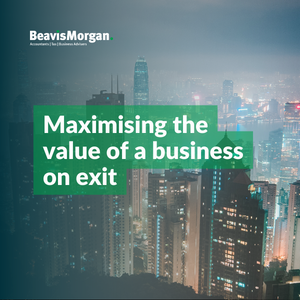There are many different reasons why a business owner may decide to exit from their business. In an ideal world, the planning required to ensure a perfect exit begins before the business is even commenced; however, this is not an obstacle for businesses that are already up and running.
As most purchasers will look at two to three years of financial results when considering buying your business, it is preferable to start this process at least 3 years prior to the exit.
At Beavis Morgan, we have the skills and flexibility to add value to the deal at any point and have done so for clients who have appointed us only a matter of days before the deal terms are finalised.
There are a number of ways to maximise the value of a business. The key steps are:
- Optimising performance
- Grooming the business for sale
- Creating the sale
Phase 1 – Optimising performance
Generate positive trends in the business’ performance; both turnover and profits are key measures that will impact on the exit value. This provides confidence that the sales process in the business is working well. The improvement process should involve:
- Reviewing products
- Analysing market segments
- Evaluating the price points
- Training and development programmes
- Detailed competitor analysis
Improve the profitability of the business by removing waste and increasing efficiency.
By the end of phase 1 business performance has been optimised, cash created to fund the next phase of the process, and sales and profits should be showing continuous and predictable improvement.
Phase 2 – Grooming the business for sale
- Protect the future revenues of the business
A buyer of the business will always seek to maximise the degree of certainty over future revenue outlook so contracts with customers and suppliers need to be robust and preferably long-term.
- Establish a management infrastructure that removes reliance on the owner. The management skills and experience required to lead the business, in the absence of the owner, need to be in place but also be flexible enough to accommodate a potential new owner
- Protect the brand of the business. Mechanisms for this include the web-presence, social media, patents and other intellectual property protection
- Reduce the debt levels of the business in order to clean up the balance sheet. The cash created in phase 1 can be used to retire debt and remove loan accounts.
At the end of phase 2 the business looks as good as it can and it is now that the sales process can formally begin.
Phase 3 – Creating the sale
The key success factor in maximising the sale price is to find a buyer who ‘needs’ to buy the business. Ideally several potential buyers have been identified at this point and an analysis of why the business is essential for each potential buyer should be carried out. Beavis Morgan has provided this support for a number of clients seeking to exit.
The information gained from the analysis enables a specific sale strategy for each potential buyer to be developed and implemented.
- Managing the negotiation process – Especially with Owner Managed Businesses, a sale is usually a once in a lifetime process, however the team at Beavis Morgan have dealt with many business sales and can provide the support, experience and coaching that a business owner may require in achieving the sale
- Anticipating and dealing with all the likely objections raised by the buyer – It is likely that the buyer will highlight items with a view to reducing the price. This is a normal part of the process but needs to be effectively dealt with to ensure that this does not create unacceptable consequences
- Manage the risk in the sales process – It is likely that as part of the contract terms for the sale, a business owner will be asked to provide a number of assurances and indemnities. It is our role in this process to restrict these as far as possible and ensure that any risks are manageable and well understood.
Undoubtedly for many privately-owned businesses, deciding to sell the business is one of the biggest decisions that shareholders will make.
At Beavis Morgan we have a team of specialists that are able to assist you throughout each of the phases. We will work with you to decide whether selling the business is the right thing to do and whether it is the right time.
Selling a business takes time and it is very important that potential sellers ensure that the business is shown in the best possible light. Therefore, planning when to sell is just as important as the sale process itself.
Our experts at Beavis Morgan can work with you to help plan the exit, as well as manage the actual sale process:
- We are available to help you maximise the value in your business and realise its potential.
- We can help you decide whether the business could be sold to management, whether a partial exit for the major shareholder would best suit or whether it should be an outright sale.
- By managing the sale process from initiation of the idea to completion, we can ease the pressure on the directors and management, help meet all the stakeholders’ objectives and leave you and the management team free to continue running the business during this crucial time.
For more information about how we can assist you and your business, please contact your usual Beavis Morgan Partner or email info@beavismorgan.com to arrange an initial no fee no obligation meeting.

